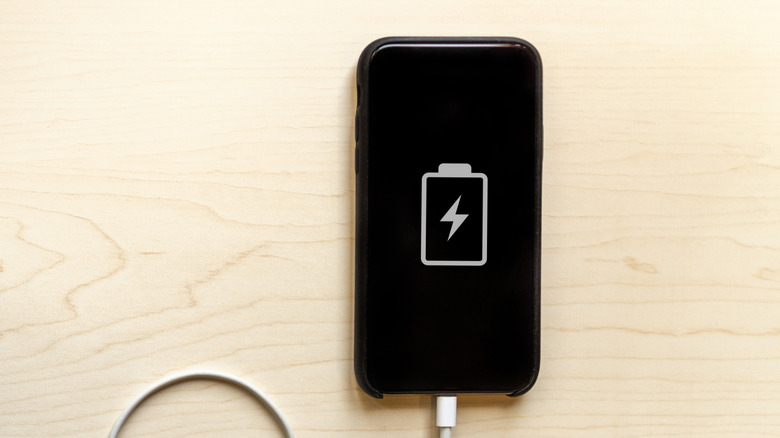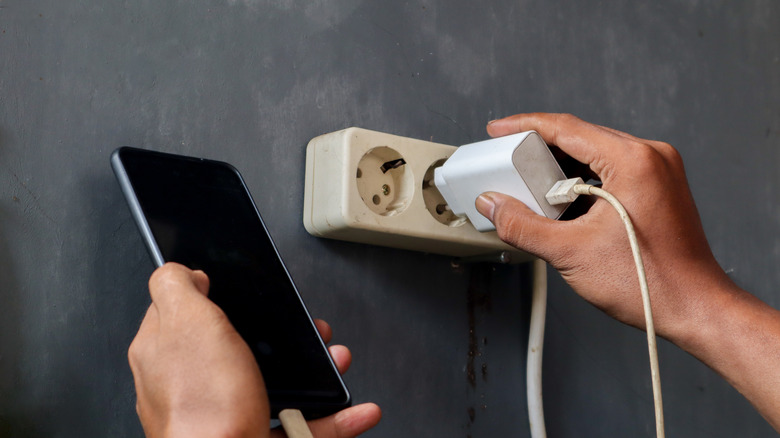Should You Leave Your Phone Charger Plugged In All The Time?
If you own a device that comes with a built-in battery, know that it's a consumable. That means it will lose its charging capacity over time. Why? Well, there are a lot of factors that come into play here, such as the supplied current strength, voltage-related temperature fluctuation, and the natural life cycle of the chemicals inside. On that note, smartphone users often face a dilemma whether they should keep their phone plugged into a charger overnight. In a nutshell, you can.
As long as you are using the official charger that comes in the phone's box, sold separately by the brand, or purchased from a reputable brand, your phone won't have issues if it is left hooked to the charging brick. Modern-age smartphones come with a slew of battery protection features, and there are dedicated hardware-level guardrails implemented within the charging bricks, too. Notably, however, fast charging "all the time" can reduce the life span, experts told The New York Times.
Thankfully, modern-age fast chargers, even those that go up to 80W, come with built-in protection against climbing temperatures, over-voltage, under-voltage, and over-current scenario protections. It doesn't matter whether you are using the phone or keep it idle, prolonged plugged-in times don't pose any serious risk. Some smartphones, such as the Red Magic 10 Pro, come with a charging separation feature that cuts off power access to the battery, and only supplies enough electric juice to the phone so that it keeps running.
How do phones keep their cool when plugged overnight?
Smartphone brands ensure safety in the face of prolonged plug-in times at various levels. Apple notes that an iPhone automatically stops charging once the battery is at capacity, even if the charging cable remains connected to an adapter. "It's safe to keep your iPhone connected to a charger overnight," the company says, adding that charging only resumes when the battery level dips below 95% due to standby power consumption from background activity. Samsung follows a similar strategy, adding that charging only resumes intermittently to make sure that when you unplug the phone, the battery is full.
The company refers to these intermittent spurts as "maintenance charges," and assures users that keeping a phone plugged in overnight will "absolutely not" pose any risks. But what about the heating that happens while charging a lithium-ion battery? Yes, it's a well-known phenomenon that high temperatures take a toll on the battery health, but in the case of smartphones, the elevated temperatures are minimal, compared to a large-format electric car battery.
"While it is technically recommended to unplug your phone once the battery reaches 100% to help extend its lifespan, the actual benefit is quite minimal," explains Samsung. Thanks to built-in chips and an array of temperature sensors, smartphones don't absorb any more electrical charge once the battery is full. Fast charging makes a device run hot, but you should be more concerned about the ambient temperature. Apple says exposing a phone to temperatures above 95 degrees Fahrenheit while charging can "permanently" reduce the battery life span.
The low-cost menace
U.K.-based charity, Electrical Safety First, recently released a detailed report covering the risks posed by counterfeit charging gear. The report classified such devices as a "particularly insidious threat" that poses "fire, serious electric shock or even electrocution" risks. But it's not just the risk to users; it's also the connected device. The lab findings conclude that such badly engineered chargers "pose a significant risk to the health and safety of users, and at the very least, present a risk of damaging connected equipment.
Missing parts, flawed internal circuit design, and missing insulation that should be there to protect users from electrical shock are a few telltale signs of such counterfeit chargers. A breakdown of the insulation barrier can result in the supplied voltage rising dramatically (from the required 5V limit to 240V mains), which could lead to serious phone damage. Independent lab tests conducted in partnership with Nemko revealed that 98% of such chargers fail mechanical and stress tests, which means they are "highly unsuitable" for use.
As far as the risks go, those pose hazards such as overheating, fire, and lethal electric shock to users. The team found that official charging adapter usually comes fitted with nearly 60 components, while the replica and imitation units usually contain 25 internal parts.. From a quality and safety standpoint, the usage of non-approved capacitors, poor internal spacing between components and the internal circuit board, bad wiring, and incorrect routing are some of the fundamental flaws that plague cheap chargers. According to the report, substandard internal capacitors "can break down at any time, giving rise to an electric shock hazard."


